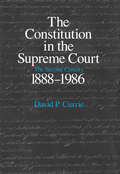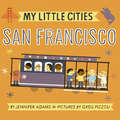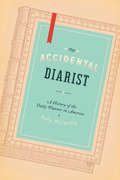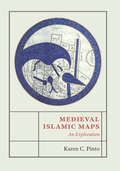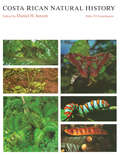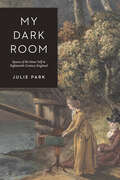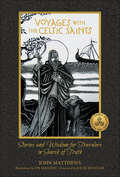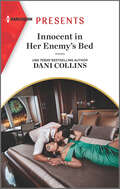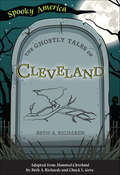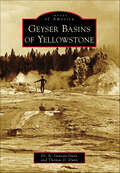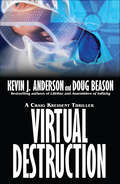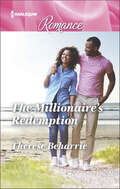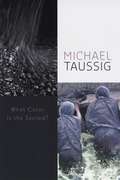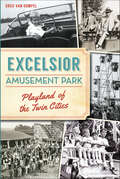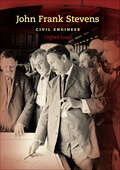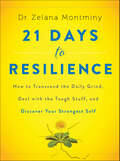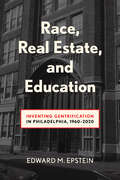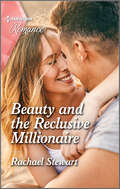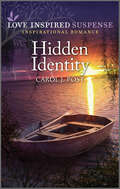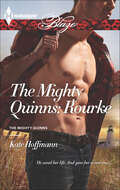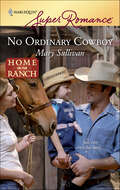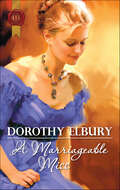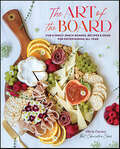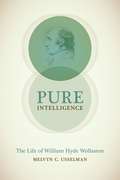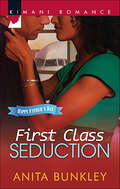- Table View
- List View
The Constitution in the Supreme Court: The Second Century, 1888–1986
by David P. CurrieThe Constitution in the Supreme Court: The Second Century traces the development of the Supreme Court from Chief Justice Fuller (1888-1910) to the retirement of Chief Justice Burger (1969-1986). Currie argues that the Court's work in its second century revolved around two issues: the constitutionality of the regulatory and spending programs adopted to ameliorate the hardships caused by the Industrial Revolution and the need to protect civil rights and liberties. Organizing the cases around the tenure of specific chief justices, Currie distinguishes among the different methods of constitutional exegesis, analyzes the various techniques of opinion writing, and evaluates the legal performance of different Courts. "Elegant and readable. Whether you are in favor of judicial restraint or judicial activism, whatever your feelings about the Warren Court, or the Renquist Court, this is a book that justifies serious study."—Robert Stevens, New York Times Book Review
My Little Cities: San Francisco
by Courtney Angela BrkicIn this delightful series written by BabyLit author Jennifer Adams and illustrated by kidlit darling Greg Pizzoli, each book showcases a different city with sweet baby-appropriate text, ridiculously charming illustrations, and a light introduction to rhyme and opposites. High-chair travelers can explore the City by the Bay: cruise along the majestic Golden Gate Bridge, play with the sea lions at Pier 39, ride cable cars up steep hills, and have a picnic in lovely San Francisco.
The Accidental Diarist: A History of the Daily Planner in America
by Molly McCarthyIn this era of tweets and blogs, it is easy to assume that the self-obsessive recording of daily minutiae is a recent phenomenon. But Americans have been navel-gazing since nearly the beginning of the republic. The daily planner—variously called the daily diary, commercial diary, and portable account book—first emerged in colonial times as a means of telling time, tracking finances, locating the nearest inn, and even planning for the coming winter. They were carried by everyone from George Washington to the soldiers who fought the Civil War. And by the twentieth century, this document had become ubiquitous in the American home as a way of recording a great deal more than simple accounts.In this appealing history of the daily act of self-reckoning, Molly McCarthy explores just how vital these unassuming and easily overlooked stationery staples are to those who use them. From their origins in almanacs and blank books through the nineteenth century and on to the enduring legacy of written introspection, McCarthy has penned an exquisite biography of an almost ubiquitous document that has borne witness to American lives in all of their complexity and mundanity.
Medieval Islamic Maps: An Exploration
by Karen C. PintoHundreds of exceptional cartographic images are scattered throughout medieval and early modern Arabic, Persian, and Turkish manuscript collections. The plethora of copies created around the Islamic world over the course of eight centuries testifies to the enduring importance of these medieval visions for the Muslim cartographic imagination. With Medieval Islamic Maps, historian Karen C. Pinto brings us the first in-depth exploration of medieval Islamic cartography from the mid-tenth to the nineteenth century. Pinto focuses on the distinct tradition of maps known collectively as the Book of Roads and Kingdoms (Kitab al-Masalik wa al-Mamalik, or KMMS), examining them from three distinct angles—iconography, context, and patronage. She untangles the history of the KMMS maps, traces their inception and evolution, and analyzes them to reveal the identities of their creators, painters, and patrons, as well as the vivid realities of the social and physical world they depicted. In doing so, Pinto develops innovative techniques for approaching the visual record of Islamic history, explores how medieval Muslims perceived themselves and their world, and brings Middle Eastern maps into the forefront of the study of the history of cartography.
Costa Rican Natural History: With 174 Contributors
by Daniel H. JanzenThis volume is a synthesis of existing knowledge about the flora and fauna of Costa Rica. The major portion of the book consists of detailed accounts of agricultural species, vegetation, amphibians, reptiles, mammals, birds, and insects. "This is an extraordinary, virtually unique work. . . . The tremendous amount of original, previously unpublished, firsthand information is remarkable."—Peter H. Raven, Director, Missouri Botanical Garden "An essential resource for anyone interested in tropical biology. . . . It can be used both as an encyclopedia—a source of facts on specific organisms—and as a source of ideas and generalizations about tropical ecology."—Alan P. Smith, Ecology
My Dark Room: Spaces of the Inner Self in Eighteenth-Century England
by Julie ParkExamines spaces of inner life in eighteenth-century England to shed new light on interiority in literature and visual and material culture. In what kinds of spaces do we become most aware of the thoughts in our own heads? In My Dark Room, Julie Park explores places of solitude and enclosure that gave eighteenth-century subjects closer access to their inner worlds: grottos, writing closets, landscape follies, and the camera obscura, that beguiling “dark room” inside which the outside world in all its motion and color is projected. The camera obscura and its dreamlike projections within it served as a paradigm for the everyday spaces, whether in built environments or in imaginative writing, that generated the fleeting states of interiority eighteenth-century subjects were compelled to experience and inhabit.My Dark Room illuminates the spatial and physical dimensions of inner life in the long eighteenth century by synthesizing material analyses of diverse media, from optical devices and landscape architecture to women’s intimate dress, with close readings of literary texts not traditionally considered together, among them Andrew Marvell’s country house poem Upon Appleton House, Margaret Cavendish’s experimental epistolary work Sociable Letters, Alexander Pope’s heroic verse epistle Eloisa to Abelard, and Samuel Richardson’s novel Pamela. Park also analyzes letters and diaries, architectural plans, prints, drawings, paintings, and more, drawing our attention to the lively interactions between spaces and psyches in private environments. Park’s innovative method of “spatial formalism” reveals how physical settings enable psychic interiors to achieve vitality in lives both real and imagined.
Voyages with the Celtic Saints: Stories and Wisdom for Travelers in Search of Truth
by John MatthewsVoyages with the Celtic Saints recounts the inspired lives of the Celtic saints, who carried the torch of the new faith of Christianity to the wild tribespeople of Britain and Ireland. Finding many parallels between their own wisdom and that of the Druids and other teachers of the Celtic people, they adapted their own teachings to include and reshape that of the older wisdom. • Features stories from the lives of 14 inspiring Celtic saints who lived between the third and seventh centuries CE • Scholar John Matthews retells and provides commentary on these stories, making them relevant and accessible to modern readers • Meditation notes and questions at the end of each chapter for those wishing to deepen their understanding of the stories and question their own voyage • Updates from prior edition with new illustrations by renowned artist Joe Machine and two additional entries on women saints, St. Gwenfrewi and St. Goibniu • Includes inspiring foreword by David Spangler, one of the founding figures of the modern New Age movement
Innocent in Her Enemy's Bed
by Dani CollinsA woman gets in bed with her family’s enemy for revenge in this sexy enemies-to-lovers romance by USA Today–bestselling author Dani Collins.Keeping her enemy close . . . means getting far closer than she thought!Ilona Callas is aware that Leander Vasilou will do anything for revenge against her stepfamily. She just never pictured herself becoming the formidable Greek businessman’s ally! Yet uniting with Leander will give Ilona freedom and financial independence for the first time.Since clawing his way to the top after being betrayed, Leander exists alone. Ilona should be his ticket to vengeance . . . until an explosive moment of intimacy changes everything. So begins a sensual back-and-forth that will lead to one place: their marriage bed!
The Ghostly Tales of Cleveland (Spooky America)
by Beth A. RichardsGhost stories from the CLE have never been so creepy, fun, and full of mystery! The haunted history of Cleveland comes to life--even when the main players are dead. Visit the beautiful, majestic--and haunted--Franklin Castle. Explore the tunnels beneath the Soldiers' and Sailors' Monument to see if the lingering spirits show themselves. Hop the rails for a spooky train ride, where ghosts from a long-ago accident haunt the railcar they traveled in. Dive into this spooky chapter book for suspenseful tales of bumps in the night, paranormal investigations, and the unexplained; just be sure to keep the light on.
Geyser Basins of Yellowstone
by Thomas D. Dunn N. Genean DunnYellowstone National Park contains over half the world�s active geysers, with more than 700 within its 3,472 square miles. The most famous geyser is Old Faithful, named in 1870 during the Washburn-Langford-Doane Expedition. In 1871, the US Geological and Geographical Survey, led by Dr. F.V. Hayden, reached the Upper Geyser Basin. In just over a day, the explorers witnessed eruptions of many geysers still seen today, including Giantess, Beehive, Grotto, Castle, and Old Faithful. Yellowstone became the first National Park in 1872. Since then, visitors have come in increasing numbers to witness the unique geysers, numerous wildlife, and spectacular scenery.
Virtual Destruction (The Craig Kreident Thrillers)
by Kevin J. Anderson Doug BeasonAt the Lawrence Livermore National Laboratory in California—one of the nation’s premier nuclear-weapons design facilities—high-level physicists operate within heavy security to model and test new warhead designs. But politics can be just as dangerous as the weapons they design, and with gigantic budgets on the line, scientific egos, and personality clashes, research can turn deadly. When a prominent and abrasive nuclear-weapons researcher is murdered inside a Top Security zone, FBI investigator Craig Kreident is brought in on the case—but his FBI security clearance isn’t the same as a Department of Energy or Department of Defense clearance, and many of the clues are “sanitized” before he arrives. Kreident finds that dealing with red tape and political in-fighting might be more difficult than solving a murder. Written by two insiders who have worked at Lawrence Livermore, Virtual Destruction is not only a gripping thriller and complex mystery, but a vivid portrayal of an actual US nuclear-design facility.
The Millionaire's Redemption
by Therese BeharrieA proposal of convenience! Jacques Brookes wants the world to see the real him— the man behind the headlines. When he catches the eye of beautiful Lily Newman, he knows she could be just the woman to help him… Jacques screams trouble—Lily&’s already had her heart broken by her cheating ex-fiancé. But by pretending to be Jacques s girlfriend she may be the only person who can help him on his journey to redemption. And he could be just what Lily needs to believe in love again!
What Color Is the Sacred?
by Michael TaussigOver the past thirty years, visionary anthropologist Michael Taussig has crafted a highly distinctive body of work. Playful, enthralling, and whip-smart, his writing makes ingenious connections between ideas, thinkers, and things. An extended meditation on the mysteries of color and the fascination they provoke, What Color Is the Sacred? is the next step on Taussig’s remarkable intellectual path. Following his interest in magic and surrealism, his earlier work on mimesis, and his recent discussion of heat, gold, and cocaine in My Cocaine Museum,this book uses color to explore further dimensions of what Taussig calls “the bodily unconscious” in an age of global warming. Drawing on classic ethnography as well as the work of Benjamin, Burroughs, and Proust, he takes up the notion that color invites the viewer into images and into the world. Yet, as Taussig makes clear, color has a history—a manifestly colonial history rooted in the West’s discomfort with color, especially bright color, and its associations with the so-called primitive. He begins by noting Goethe’s belief that Europeans are physically averse to vivid color while the uncivilized revel in it, which prompts Taussig to reconsider colonialism as a tension between chromophobes and chromophiliacs. And he ends with the strange story of coal, which, he argues, displaced colonial color by giving birth to synthetic colors, organic chemistry, and IG Farben, the giant chemical corporation behind the Third Reich. Nietzsche once wrote, “So far, all that has given colour to existence still lacks a history.” With What Color Is the Sacred? Taussig has taken up that challenge with all the radiant intelligence and inspiration we’ve come to expect from him.
Excelsior Amusement Park: Playland of the Twin Cities (Landmarks)
by Greg Van GompelMinneapolis roared into the 1920s as a major metropolis, but it lacked the kind of outdoor amusement facilities common elsewhere across the country. In 1925, Fred W. Pearce introduced the Twin Cities to his "Picnic Wonderland." Crowds eagerly poured onto the shores of Lake Minnetonka by the trolley load. Luckily, Excelsior Park survived the Great Depression and World War II on the strength of its celebrity acts. Changes in the forms of transportation, combined with innovations in the outdoor entertainment industry such as Disneyland and an aging infrastructure, eventually forced the park to close its gates.
John Frank Stevens: Civil Engineer (Railroads Past and Present)
by Clifford FoustOne of America's foremost civil engineers of the past 150 years, John Frank Stevens was a railway reconnaissance and location engineer whose reputation was made on the Canadian Pacific and Great Northern lines. Self-taught and driven by a bulldog tenacity of purpose, he was hired by Theodore Roosevelt as chief engineer of the Panama Canal, creating a technical achievement far ahead of its time. Stevens also served for more than five years as the head of the US Advisory Commission of Railway Experts to Russia and as a consultant who contributed to many engineering feats, including the control of the Mississippi River after the disastrous floods of 1927 and construction of the Boulder (Hoover) Dam. Drawing on Stevens's surviving personal papers and materials from projects with which he was associated, Clifford Foust offers an illuminating look into the life of an accomplished civil engineer.
21 Days to Resilience: How to Transcend the Daily Grind, Deal with the Tough Stuff, and Discover Your Strongest Self
by Zelana Montminy“21 Days to Resilience gives us a powerful map we can apply to grab ahold of radical wellbeing and happiness in our daily lives, for real.” —Tara Stiles, bestselling author of Clean Mind, Clean BodyHappiness is not about wishful thinking, good luck, or avoiding negative thoughts. In fact, the only path to true happiness requires seeing challenges as opportunities and discovering emotional strength during times of struggle. In other words, it’s about resilience—a quality most of us want to possess. The big issue is that no one knows how to access it in their day-to-day life. How we actually attain the skills to become resilient has been left out of the conversation. Until now.In 21 Days to Resilience, Dr. Zelana Montminy, a leading expert in positive psychology, offers a practical, science-backed toolkit to develop your capacity to handle whatever life throws your way—and thrive. Each day of her powerful program, Dr. Montminy introduces a key trait necessary to improve resiliency and enhance wellbeing, such as gratitude, focus, playfulness, self-respect, and flexibility, then provides three simple tasks to accomplish that day—one in the morning, one during the day, and one in the evening. In addition, the book offers a “Take Stock” section that will help you gauge your current level of skill and each chapter ends with a “Lifelong” exercise that offers ways to build the skill as needed to keep your resiliency muscles strong.Combining proven science, unique exercises, and insights from real-life experience, 21 Days to Resilience lays the foundation for happiness and shows you how to build your strength to carry you through the rest of your life.
Race, Real Estate and Education: Inventing Gentrification in Philadelphia, 1960-2020 (Urban Life, Landscape and Policy)
by Edward M. EpsteinPhiladelphia’s urban renewal efforts in the 1950s, which re-envisioned the city as a residential enclave, were an early example of gentrification. In West Philadelphia in the 1960s, a coalition of universities and hospitals went further, initiating K-12 public school improvements meant to attract an affluent and whiter population. As Edward Epstein details in Race, Real Estate, and Education, these interventions discounted the negative impact they could have on neighborhood residents. Epstein outlines the citywide context for the plan to create “University City” in West Philadelphia. He recounts the attempts to correct the segregation, overcrowding, and authoritarian management that plagued Philadelphia’s public schools. As the West Philadelphia Corporation, the proxy for the universities and hospitals, initiated gentrification efforts, the local community resisted and protested, causing the project to fail. The effort was revived with spectacular success, however, with the launch of the well-funded Penn Alexander School in 2001. Race, Real Estate, and Education shows how the pursuit of urbanist ideals sometimes deepens neighborhood injustice. Epstein’s exploration of whether Philadelphia’s overall approach was beneficial or misguided presents a cautionary tale. In the series Urban Life, Landscape, and Policy
Beauty and the Reclusive Millionaire
by Rachael StewartAn unforgettable Greek escape…with the man she never forgot!A-list actress Catherine Wilde has it all, but behind closed doors she is fighting personal battles. So the chance to escape to the private Greek island of her best friend&’s brother, Alaric, offers the tranquility she craves. Except seeing Alaric again sets her heart rate soaring. Life might have changed him, but he can still make her feel alive—and when the torch she once held for him reignites, it&’s impossible to ignore! &“This is a gorgeous second chance romance about a couple who truly belong together. Warm, emotional and with the right amount of steam. Happy sighs.&”-Goodreads on Surprise Reunion with His Cinderella &“This is a delightful, moving, contemporary romance…. I should warn you that this is the sort of book that once you start you want to keep turning the pages until you've read it. It is an enthralling story to escape into and one that I thoroughly enjoyed reading. I have no hesitation in highly recommending it….&”-Goodreads on Tempted by the Tycoon's Proposal
Hidden Identity: Detecting Danger Emergency Reunion Hidden Identity
by Carol J. PostRUNNING FOR HER LIFE When Meagan Berry is caught on camera rescuing a senator, she knows her cover's been blown. After faking her death, she's spent months keeping her identity hidden from an abusive ex-fiancé. Now he's on her trail in remote Cedar Key, Florida. Officer Hunter Kingston knows Meagan's running from something, but he can't imagine anyone wishing harm on the pretty artist. Then an intruder breaks into Meagan's house, and Hunter promises not to leave her side. But when evidence from the crime scene doesn't add up, Hunter wonders whether he should trust Meagan. Yet he will have to put his faith in this mysterious beauty if they both want to live to see another day.
The Mighty Quinns: Rourke (The Mighty Quinns)
by Kate HoffmannHer hero. Her savior. And her undoing. Rourke Quinn found her on the storm-tossed shores of Cape Breton. The woman in his arms was unconscious and bleeding. And Rourke knew her. Annie MacIntosh was the town outcast-a wild thing. And as untamed and beautiful as the Atlantic itself. This storm was just the thing to keep Rourke as close to her as he dared.... Annie grew up fiercely independent. She was a survivor, needing no one and nothing. She cut herself off from the town and society, relying only on her raw need for survival. But Rourke unleashes a hunger she never knew existed. This man-this stranger-satiates an appetite she hardly dared imagine. It's more exciting and more turbulent than that storm that rages outside. And Rourke has only one chance with the wild girl he can't live without...before losing her to a world he can never be part of...
No Ordinary Cowboy (Home on the Ranch #34)
by Mary SullivanShe'd rather be anywhere than here in Ordinary, Montana. Tackling the books for a failing ranch as a favor to a friend is not city girl Amy Graves's scene. And every time Hank Shelter stonewalls her search for the truth, she wants to be gone yesterday. Seriously.Still, something about the Sheltering Arms calls to her. Maybe it's the open spaces. Maybe it's the inner-city kids having the time of their lives here. Or maybe it's Hank, who is proving too good, too kind to be real. Despite herself, Amy's falling for his charm. But to put the ranch to rights she needs to know what he's hiding. Even if it destroys the sweet thing developing between them.
A Marriageable Miss
by Dorothy ElburyWhen Miss Helena Wheatley's wealthy father decides she should marry nobility, only her ingenuity keeps her from being trapped in an unwelcome marriage! But with her father suddenly falling ill, she is forced to turn to one of her prospective suitors and beg for his help.Richard Standish, the Earl of Markfield, honorably agrees to aid Helena. He'll squire her around Town until her father recovers. Though when they are caught alone together, their temporary agreement suddenly looks set to become a lot more permanent….
The Art of the Board: Fun & Fancy Snack Boards, Recipes & Ideas for Entertaining All Year
by Olivia CarneyWith over 75 seasonally inspired, approachable snack boards, recipes, and cocktails, The Art of the Board has all you need for fun, stress-free entertaining year-round. Packed with tips, tricks, and ideas, you’ll be inspired to whip up your next snack board masterpiece—whether it’s creatively plating your Thanksgiving leftovers to impress your family or wowing your friends with your knowledge of fancy cheese and charcuterie. Not sure where to start? No problem! The in-depth introduction walks you through equipment and ingredients, and the Hopeless Hostess Appendix covers everything from Board Care 101 to step-by-step explanations and photographs that show how to bring your skills to the next level. There’s even helpful suggestions to make your cheese plates travel-friendly so you never arrive empty-handed. And since each board is labeled with difficulty level, approximate cost, and dietary accommodations, you’ll always find a showstopper to fit your lifestyle and budget.
Pure Intelligence: The Life of William Hyde Wollaston (Synthesis Ser.)
by Melvyn C. UsselmanWilliam Hyde Wollaston made an astonishing number of discoveries in an astonishingly varied number of fields: platinum metallurgy, the existence of ultraviolet radiation, the chemical elements palladium and rhodium, the amino acid cystine, and the physiology of binocular vision, among others. Along with his colleagues Humphry Davy and Thomas Young, he was widely recognized during his life as one of Britain’s leading scientific practitioners in the first part of the nineteenth century, and the deaths of all three within a six-month span, between 1828 and 1829, were seen by many as the end of a glorious period of British scientific supremacy. Unlike Davy and Young, however, Wollaston was not the subject of a contemporary biography, and his many impressive achievements have fallen into obscurity as a result.Pure Intelligence is the first book-length study of Wollaston, his science, and the environment in which he thrived. Drawing on previously-unstudied laboratory records as well as historical reconstructions of chemical experiments and discoveries, and written in a highly accessible style, Pure Intelligence will help to reinstate Wollaston in the history of science, and the pantheon of its great innovators.
First Class Seduction (Happy Father's Day)
by Anita BunkleyShe meets him at a sizzling hot spot in Acapulco…and spends the night swaying in his arms. But globetrotting flight attendant Lori Myles is stunned when her sexy Latin dance partner turns up on her flight to Houston. Graceful, gorgeous security expert Ramon Vidal specializes in the kind of seductive protection Lori secretly craves.How could Ramon forget the smoldering beauty undulating to a sensual salsa in the smoky shadows of that nightclub? Now that Ramon's found her again, he isn't letting her go. And when they're caught up in a dangerous smuggling ring that threatens their skyrocketing relationship, he's working overtime to keep Lori safe. Will their flight of passion lead to a lifetime of love?
